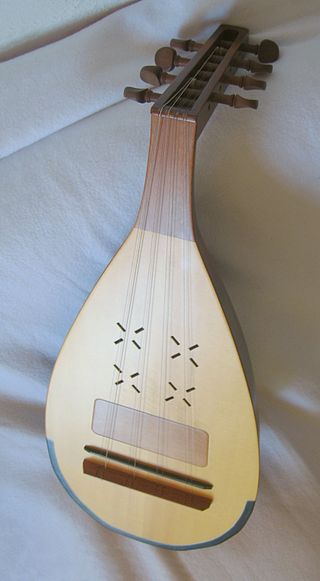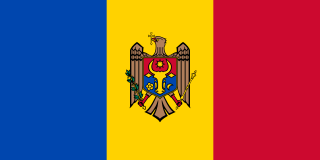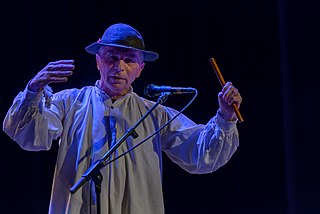Related Research Articles

Klezmer is an instrumental musical tradition of the Ashkenazi Jews of Central and Eastern Europe. The essential elements of the tradition include dance tunes, ritual melodies, and virtuosic improvisations played for listening; these would have been played at weddings and other social functions. The musical genre incorporated elements of many other musical genres including Ottoman music, Baroque music, German and Slavic folk dances, and religious Jewish music. As the music arrived in the United States, it lost some of its traditional ritual elements and adopted elements of American big band and popular music. Among the European-born klezmers who popularized the genre in the United States in the 1910s and 1920s were Dave Tarras and Naftule Brandwein; they were followed by American-born musicians such as Max Epstein, Sid Beckerman and Ray Musiker.
Romania has a multicultural music environment which includes active ethnic music scenes. Traditional Romanian folk music remains popular, and some folk musicians have come to national fame.

The Romanian word lăutar denotes a class of musicians.
Manele is a genre of pop folk music from Romania.

Grigoraș Ionică Dinicu was a Romanian violin virtuoso and composer of Roma ethnicity. He is most famous for his often-played virtuoso violin showpiece "Hora staccato" (1906) and for making popular the tune Ciocârlia, composed by his grandfather Angheluș Dinicu for "nai". It is rumored that Jascha Heifetz once said that Grigoraș Dinicu was the greatest violinist he had ever heard. In the 1930s he was involved in the political movement of the Romanian Roma and was made honorary president of the "General Union of the Romanian Roma". Other well known compositions are: Hora mărțișorului, Ceasornicul and Căruța poștei.
Ciocârlia is a Romanian tune, allegedly composed by the Romani-Romanian pan flute player Angheluş Dinicu in the virtuosic style of the urban lăutarească music from late 19th century.

The cobza is a multi-stringed instrument of the lute family of folk origin popular in the Romanian, Moldovan and Hungarian folk music. It is considered the oldest accompaniment instrument in the region comprising Romania and Moldova. Its usage in Hungary was revived following the Táncház movement of the late 20th century.
The term Romani style refers to the way Eastern European music is played in coffeehouses and restaurants, at parties, and sometimes on-stage in European cities. Music played in this style differs from actual Romani music played by Romani and Sinti people, many of whom regard the term "gypsy" as a slur when applied to their community.

Nicolae Sulac was a folk music singer from the Republic of Moldova.
In Romania, the syntagm muzică populară is used to denote a musical genre based on folklore, but distinct from it. The distinction is both in form and essence and it arises mainly from the commercial aspect of the popular music. In English the term is ambiguous since it could also refer to Romanian pop music.
In music, the Ukrainian Dorian scale is a modified minor scale with raised 4th and 6th, and lowered 7th degrees, often with a variable 4th degree. It has traditionally been common in the music of Eastern Europe, Southeast Europe, and the Mediterranean including Jewish, Greek, Ukrainian, and Romanian music. Because of its widespread use, this scale has been known by a variety of names including Altered Dorian, Hutsul mode and Mi Shebeirach. It is also closely related to the Nikriz pentachord found in Turkish or Arabic maqam systems.
A name in Romanian tradition consists of a given name (prenume) and a family name (surname). In official documents, surnames usually appear before given names.
Yulia Tsibulskaya is a Moldovan-Russian composer. She is known in Russian as Юлия Георгиевна Цибульская and in Polish as Julia Cybulska.

Literature of Moldova comprises the literature of the principality of Moldavia, the later trans-Prut Moldavia, Bessarabia, the Moldavian Autonomous Soviet Socialist Republic, the Moldavian Soviet Socialist Republic, and the modern Republic of Moldova, irrespective of the language. Although there has been considerable controversy over linguistic identity in Moldova, the Moldovan and Romanian languages are virtually identical and share a common literary history. Moldovan literature, therefore, has considerable overlap with Romanian literature.

Grigore Leșe is a Romanian musician.

Roots Revival is an international cultural project which reunites professional musicians from different countries in an effort to connect the musical styles, traditions and instruments that are specific to each geographical area they come from, thus creating a bridge between cultures using authentic music. The concept founded by Mehdi Aminian.

Three Rondos on Slovak Folk Tunes, Sz. 84, BB 92, also referred to as Three Rondos on Folk Tunes, is a collection of three small pieces for piano by Hungarian composer Béla Bartók.

Doina, or Doină, is a political poem by the Romanian Mihai Eminescu. It was first published in 1883 and is therefore seen by some as Eminescu's final work in verse, although it may actually be an 1870s piece, inspired or enhanced by the perceived injustice of the Berlin Treaty. A variation of the doina, picked up from Romanian folklore, it is noticeably angry to the point of rhetorical violence, a radical expression of Romanian nationalism against invading "foreigners", with additional hints of ecopoetry and "anti-technicist" discourse. Doina delineates the ideal geographical space of Greater Romania, at a time when Romanian-inhabited regions were divided between an independent kingdom and multinational empires. Its final lines call on Stephen the Great, depicted as a sleeping hero, to take up the cause of Romanians and chase foreigners out with the sound of his horn. The same basic themes appear in another poem by Eminescu, the anthem-like La arme, which is sometimes discussed as a variant of Doina.
Love is a Story (2015) is a Romanian feature film, directed by Cristina Jacob. The film is about two young artists who begin their love story during the winter holidays, in an old and charming city of Transylvania.

"Cântă cucu-n Bucovina" or "Cântă cucu în Bucovina" is a Romanian folk song, more precisely a doină, composed in 1904 by Constantin Mandicevschi. The lyrics are original, while the melody is a modified Bukovinian mourning song. Mandicevschi composed it at the request of Spiru Haret for the 400th anniversary of the death of Prince of Moldavia Stephen the Great, which was commemorated in Putna in the same year. The song is also known as "Cântă cucul, bată-l vina", "Bucovină, plai cu flori", "Cântec pentru Bucovina" and "Cântec despre Bucovina".
References
- ↑ The Jews of North America
- ↑ Béla Bartók Essays
- ↑ The Romanian Doina
- 1 2 Hora lunga (doina, cantec lung)
- 1 2 World Library Of Folk And Primitive Music Vol 17: Romania - Linear Notes by Speranța Rădulescu
- ↑ Stacy Phillips - Klezmer collection for C instruments
- ↑ Interview with Grigore Leşe
- ↑ Peter van der Merwe - Origins of the Popular Style
- ↑ Garfias, Robert. "The Romanian Doina". Academia. Retrieved 3 February 2021.

